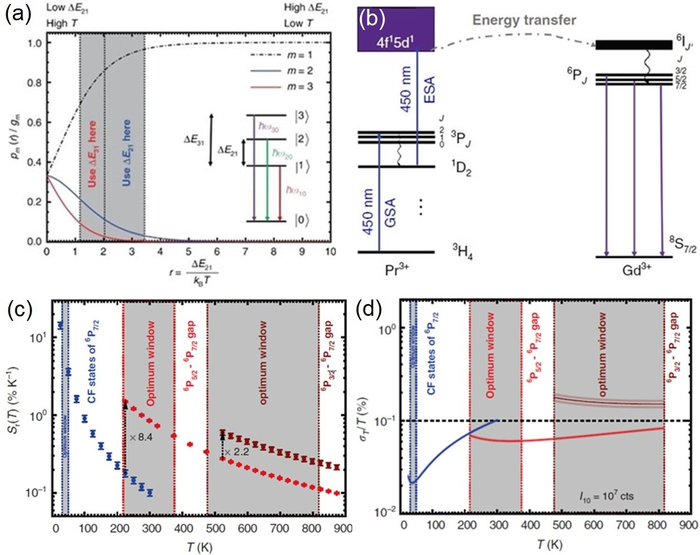Luminescent thermometers become progressively essential for remote, non-invasive temperature sensing at particularly small lateral dimensions, as contact-based detection methods only function in a partial way or even not at all. Standard application areas are temperature recording on catalytic surfaces or in biomedical procedures.
 (a) Thermodynamic foundation for optimum performance of an excited three-level Boltzmann-based luminescent thermometer; (b) Indirect upconversion excitation scheme for Gd 3+ by energy transfer from the 4f15d1-related electronic states of Pr3+; (c-d) Assessment of the optimum performance of a wide-range multilevel luminescent Boltzmann thermometer based on Gd3+ in YAl3(BO3)4:Pr3+,Gd3+: (c) relative sensitivities Sr, (d) temperature uncertainty σT. (Image Credit: by Dechao Yu, Huaiyong Li, Dawei Zhang, Qinyuan Zhang, Andries Meijerink and Markus Suta).
(a) Thermodynamic foundation for optimum performance of an excited three-level Boltzmann-based luminescent thermometer; (b) Indirect upconversion excitation scheme for Gd 3+ by energy transfer from the 4f15d1-related electronic states of Pr3+; (c-d) Assessment of the optimum performance of a wide-range multilevel luminescent Boltzmann thermometer based on Gd3+ in YAl3(BO3)4:Pr3+,Gd3+: (c) relative sensitivities Sr, (d) temperature uncertainty σT. (Image Credit: by Dechao Yu, Huaiyong Li, Dawei Zhang, Qinyuan Zhang, Andries Meijerink and Markus Suta).
The lanthanoid ions have emerged as the foremost luminescent ions in this area because of their robust electronic structure with selected radiatively discharging excited levels having energy separations in the order of standard thermal energies.
In this scenario, the intensity ratio of the associated emission peaks from two thermally coupled excited levels from the 4fn configuration is based on Boltzmann’s law. This is appealing for applications as the calibration model is straightforward, can be linearized and the fitting parameters recognized with individually measurable quantities.
Regrettably, Boltzmann thermometers only provide high measurement precision in a restricted temperature range that relies on the utilized energy gap. A basic thermodynamic solution to surpass this obstacle and to broaden the dynamic range of the luminescent thermometer is the usage of over two excited states.
Targeting at high-temperature luminescence thermometry creates several new practical problems, however. A noticeable issue is the appearance of a sloping background because of black-body radiation.
As the concentration of thermal radiation scales with the fourth power of temperature and the maximum of the associated emission spectrum change toward the visible range at higher temperatures, a perfect wide-range luminescent thermometer should discharge in the ultraviolet (UV) range.
Gd3+ (4f7) fulfills all these necessities for effective wide-range luminescence thermometry but is regrettably a weak UV absorber. Thus, the researchers developed an alternative concept.
Since the blue InGaN LED discharging at about 450 nm has gone through a remarkable optimization that enables reaching high incident power densities with blue LEDs very easily these days, the team used Pr3+ (4f2) as a sensitizer for Gd3+.
Pr3+ absorbs at 450 nm and under adequately high irradiance, this ion is stimulated into 4f15d1-based states with energies in the UV range, similar to the excited levels of Gd3+. This allows stimulating Gd3+ by means of an inexpensive 450 nm light source.
This conceptually different method also restricts the choice for a possible host compound. It should be stable over a broad range of temperatures, favorably without any phase transition.
Furthermore, the 5d orbitals are a lot more sensitive to the locally adjacent ligand field, which needs a host that moves the energy of the excited 4f15d1 configuration of Pr3+ to a range that is similar to the excited levels of Gd3+.
Finally, the host structure should basically keep the doped Gd3+ ions at a distance from each other. This enables a higher fraction of Gd3+ ions to be incorporated to boost the absorption strength while avoiding energy migration processes that could result in concentration quenching of the UV luminescence of Gd3+. The huntite-type crystallizing borate YAl3(BO3)4 matches all these necessities and is a perfectly suitable host compound to test these necessities.
Upon addition of all these design approaches, the researchers could show that YAl3(BO3)4:Pr3+, Gd3+ can be used as a practical luminescent thermometer with continually low relative measurement uncertainty (< 0.1%) in the range between 30 K and 800 K. The present work thus signifies the first example of a broad-range luminescent Boltzmann thermometer that also includes real-world concerns in its design.
Journal Reference:
Yu, D., et al. (2021) One ion to catch them all: Targeted high-precision Boltzmann thermometry over a wide temperature range with Gd3+. Light Science & Applications. doi.org/10.1038/s41377-021-00677-5.